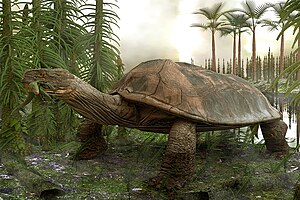Carbonemys
| Carbonemys | ||||||||||||
|---|---|---|---|---|---|---|---|---|---|---|---|---|

Artistic reconstruction of life by Carbonemys cofrinii |
||||||||||||
| Temporal occurrence | ||||||||||||
| Late Paleocene ( Thanetium ) | ||||||||||||
| 59.2 to 56 million years | ||||||||||||
| Locations | ||||||||||||
| Systematics | ||||||||||||
|
||||||||||||
| Scientific name | ||||||||||||
| Carbonemys | ||||||||||||
| Cadena , Ksepka , Jaramillo & Bloch , 2012 | ||||||||||||
| Art | ||||||||||||
|
||||||||||||
Carbonemys is an extinct genus of the Podocnemididae , a turtle family from the group of the turn-neck turtles (Pleurodira). Carbonemys lived in the late Paleocene in what is now Colombia . It is the only species of Carbonemys cofrinii . Carbonemys was the largest known tortoise of the Paleocene and, along with Titanoboa , Puentemys and Cerrejonisuchus, the largest representative of the Cerrejón fauna .
features
The only fossil that can be safely assigned to Carbonemys is a crushed fossil skull 21 cm long and 13 cm wide. Carbonemys had a long and wide snout and a large upper jaw. Like all Podocnemididae, the species lacked a nasal bone . A derived characteristic compared to the rest of this group are the prefrontals and postorbitals, which, unlike all other genera, touch each other posteolaterally. Carbonemys did not have tooth-like extensions on the upper jaw; the occlusal surface was formed by the intermaxillary bone , the jaws and the palatine bone. It had a smooth surface without grooves. Although there are no other clearly identified fossils of Carbonemys , a back armor was found in the same place as the skull, which could be assigned to the genus in its dimensions as well as in its construction. It is 173 cm long, oval in shape and has an indentation in the neck. The belly armor is only fragmentarily preserved. It reached around 60% of the length of the back armor. With a body length of around 2 m, Carbonemys was next to the sympatric Puentemys the largest tortoise of the Paleogene and reached about the same size as a leatherback tortoise ( Dermochelys coriacea ). Among the turn-neck turtles , only Stupendemys geographicus reached an even greater length.
Site, fossil material and paleoecology
The holotype of the genus, a skull crushed on the upper side (inventory number UF / IGM 41), was found in 2005 in the La Puente pit of the Colombian El Cerrejón mine . It comes from a layer of clay at a depth of around 245 m, which also contained the remains of the snake species Titanoboa , Puentemys and the crocodile Cerrejonisuchus and is dated to 55-58 mya . The back armor, possibly from Carbonemys , comes from the same find layer. The Cerrejón paleoflora consisted of Foveotricolpites perforatus and Bombacacidites annae , among others .
Systematics and taxonomy
Using the skull from El Cerrejón, the paleontologists Edwin A. Cadena , Daniel T. Ksepka , Carlos A. Jaramillo and Jonathan I. Bloch described the genus Carbonemys and its only species, Carbonemys cofrinii, in 2012 . The generic name is made up of the Latin "carbon" for coal and the ancient Greek "Emys" for freshwater turtle. The specific epithet honors the paleontologist David Cofrin .
Carbonemys forms with its closest relatives, the extinct turtles genera Neochelys , Caninemis , Dacquemys , Shweboemys , Stereogenys and Bairdemys a monophyletic group (based on morphological analysis), together with the recent genera Erymnochelys and Peltocephalus the subfamily Erymnochelyinae forms. With a combination of morphological and molecular biological data, all recent podocnemid turtle genera ( Erymnochelys , Peltocephalus and Podocnemis ) together with Cerrejonemys from the Colombian Paleocene form a monophyletic group, which is a sister class to the relatives around Carbonemys .
swell
literature
- Edwin A. Cadena, Daniel T. Ksepka, Carlos A. Jaramillo, Jonathan I. Bloch: New Pelomedusoid Turtles from the Late Palaeocene Cerrejón Formation of Colombia and their Implications for Phylogeny and Body Size Evolution. In: Journal of Systematic Palaeontology . Vol. 10, No. 2, 2012, ISSN 1477-2019 , pp. 313-331, doi : 10.1080 / 14772019.2011.569031 .